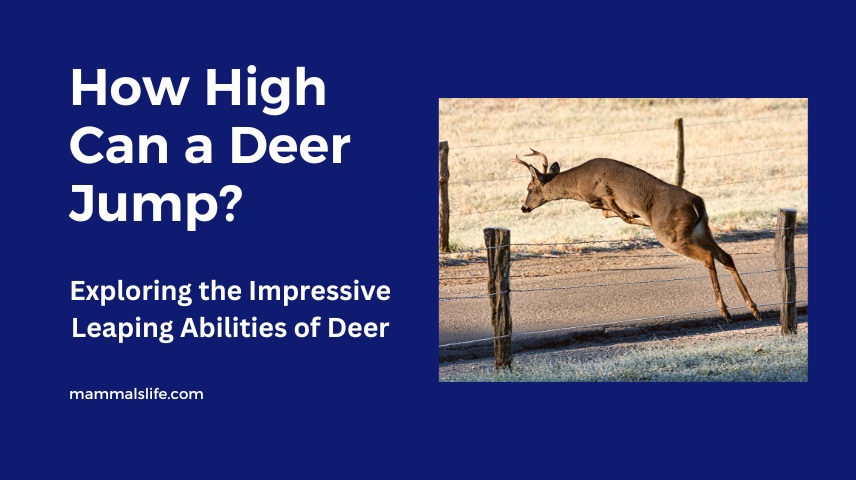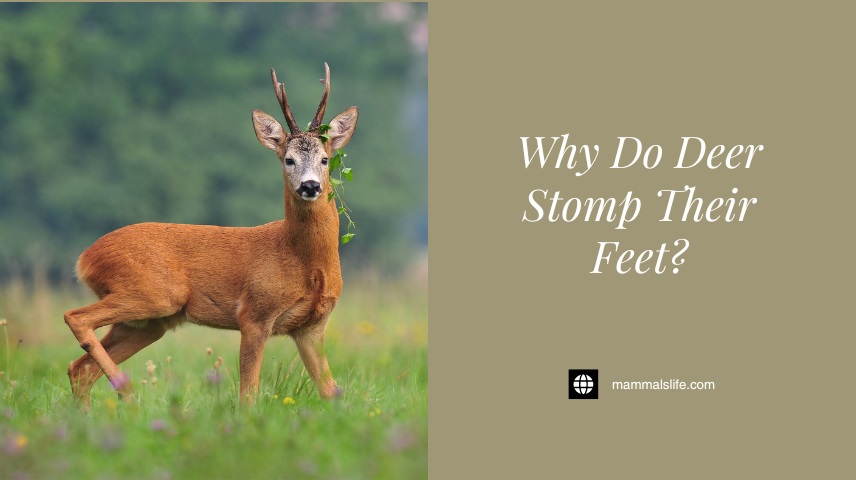Last Updated on February 22, 2025 by Mammals Life
A deer can jump up to 8 feet high and leap distances of up to 30 feet. These abilities help them evade predators.
Deer possess remarkable leaping abilities that make them agile and efficient in escaping threats. Their powerful hind legs allow them to spring over tall fences and obstacles. These impressive jumps are crucial for survival in the wild. Understanding how high a deer can jump gives insight into their behavior and habitat needs.
These skills also highlight the importance of proper fencing in areas where deer are prevalent. Wildlife enthusiasts and property owners can benefit from knowing these facts. This knowledge helps in creating safer environments for both deer and humans. Deer’s leaping abilities truly showcase the marvels of nature.
Leaping Mechanics
Deer are known for their incredible leaping abilities. They can jump over high fences and obstacles with ease. Understanding how they leap involves looking at their body structure and muscle power. Let’s dive into the mechanics of a deer’s jump.
Anatomy Of A Jump
Deer have long, powerful legs designed for leaping. Their hind legs are especially strong, providing the thrust needed for high jumps. The joints in their legs are flexible, allowing a wide range of motion. This flexibility helps them to leap both high and far.
Their hooves also play a role. They are split, giving deer better balance when they land. This makes it easier for them to run and jump on uneven ground. The spine of a deer is also quite flexible, which helps them to arch their bodies during a jump.
Muscle Power
Muscles are the engine behind a deer’s jump. Deer have powerful muscles in their hindquarters. These muscles contract quickly and forcefully, giving the deer a strong push-off.
Deer also have strong muscles in their lower legs. These muscles help them to extend their legs fully during a jump. A deer’s muscles are built for endurance, allowing them to jump multiple times without tiring quickly.
Below is a table illustrating the key muscles involved in a deer’s jump:
| Muscle Group | Function |
|---|---|
| Quadriceps | Extend the legs |
| Hamstrings | Flex the legs |
| Gluteal Muscles | Provide thrust |
| Calf Muscles | Stabilize the jump |
Understanding these mechanics gives insight into how deer can jump so high. Their body structure and muscle power work together seamlessly. This makes them one of nature’s best jumpers.
Read More – What Is a Spike Deer? A Guide to Identifying Young Bucks
Height And Distance
Deer have amazing jumping skills. They can jump very high and far. Let’s explore their leaping abilities in detail. We will look at their vertical and horizontal jumps.
Vertical Jumps
Deer can jump very high. They can jump over fences easily. The height of their vertical jumps is impressive.
| Type of Deer | Jump Height (in feet) |
|---|---|
| White-tailed Deer | Up to 8 feet |
| Mule Deer | Up to 10 feet |
White-tailed deer can jump up to 8 feet high. Mule deer can jump up to 10 feet high. This helps them escape predators.
Horizontal Leaps
Deer can also jump very far. Their horizontal leaps are quite long. This helps them cover large distances quickly.
- White-tailed Deer: Up to 30 feet
- Mule Deer: Up to 35 feet
White-tailed deer can leap up to 30 feet in one jump. Mule deer can leap up to 35 feet. These long jumps help them move fast in the wild.
Understanding how high and far deer can jump is fascinating. Their leaping skills are truly remarkable.
Species Variations
Deer are known for their impressive leaping abilities. Different species have unique jumping skills. Let’s explore how high various deer species can jump.
White-tailed Deer
The White-Tailed Deer is common in North America. They are agile and can jump high.
- White-Tailed Deer can jump up to 8 feet high.
- They can leap distances up to 30 feet.
These deer use their strong legs to escape predators. Their jumping ability helps them navigate forests and fields.
Mule Deer
Mule Deer live mostly in the western United States. They are known for their large ears and strong legs.
- Mule Deer can jump up to 10 feet high.
- They can leap distances up to 15 feet.
Mule Deer use their leaping skills to cross rugged terrains. Their jumps help them avoid dangers in the wild.
Read More – How Smart Are Deer? Understanding Their Behavior And Adaptability
Survival Strategies
Deer are known for their impressive leaping abilities. These skills are vital for their survival in the wild. Let’s explore how these jumps help deer in their daily lives.
Escaping Predators
Deer face many predators in their natural habitat. Their ability to jump high helps them escape danger quickly. A deer can jump over obstacles that block a predator’s path.
This skill gives deer a better chance to outrun threats. They can leap over fences, fallen trees, or bushes to find safety. This agility is a key survival strategy for deer.
The forest floor is full of obstacles. Deer use their jumping ability to navigate through dense forests. They can leap over rocks, streams, and other barriers.
Deer also uses jumps to move through different terrains. This includes fields, hills, and wetlands. Their strong legs help them cover long distances quickly.
Here is a table showing the average heights deer can jump:
| Type of Deer | Jump Height |
|---|---|
| White-tailed Deer | 8-10 feet |
| Mule Deer | 6-8 feet |
These heights show the amazing capabilities of deer. Their leaping skills are crucial for their survival.
Environmental Factors
Deer are known for their impressive leaping abilities. Various environmental factors influence how high a deer can jump. These factors can either enhance or limit their agility and height.
Impact Of Terrain
The terrain plays a significant role in a deer’s jumping ability. Deer thrive in environments where they can use their powerful legs to navigate obstacles. Rocky and uneven terrains can either help or hinder their leaps.
- Rocky areas: Deer uses rocks to gain extra height.
- Flat surfaces: Easier for a smooth, high jump.
- Dense forests: Limited space reduces jump height.
Weather Conditions
Weather conditions also affect how high a deer can jump. Rain, snow, and wind impact their footing and balance.
| Weather Condition | Impact on Jump |
|---|---|
| Rain | Slippery ground reduces jump height. |
| Snow | Snow can cushion landings, aiding higher jumps. |
| Wind | Strong winds can affect balance mid-air. |
Understanding these environmental factors helps us appreciate the adaptability and agility of deer. They navigate various terrains and weather conditions with remarkable skill.
Read More – Are Deer Nocturnal Or Diurnal? Exploring Their Activity Patterns
Human Interactions
Deer are remarkable creatures known for their incredible jumping abilities. Their interactions with humans often highlight these skills. These interactions usually occur in areas where human habitats intersect with deer habitats.
Fences And Barriers
Deer can jump over high fences with ease. Many fences fail to keep deer out. Typical fences stand around six feet tall. Deer can leap higher than this. They often clear fences up to eight feet in height. In some cases, deer have been seen jumping even higher.
Homeowners and farmers build fences to protect their properties. Yet, they find it challenging to outsmart these agile animals. Investing in higher fences or double-layer barriers can sometimes help. But even then, deer might still find a way through or around.
Urban Encounters
Deer are increasingly seen in urban areas. They venture into cities in search of food and shelter. This leads to many encounters with humans. Urban environments present unique challenges for deer.
Deer often jump over walls and garden fences. They also leap across roads and highways. These jumps can lead to accidents involving vehicles. Drivers must stay alert, especially in areas known for deer activity.
Urban planners are creating solutions to manage these encounters. They build wildlife corridors and install deer crossings. These measures aim to reduce accidents and make cities safer for both deer and humans.
| Barrier Type | Typical Height | Deer Jump Capability |
|---|---|---|
| Standard Fence | 6 feet | Up to 8 feet |
| Double-Layer Barrier | 6-8 feet | Can still find ways through |
| Urban Walls | Varies | Often scalable |
Frequently Asked Questions
How High Can A Deer Leap?
A deer can leap up to 10 feet high. Their powerful legs allow them to clear fences and obstacles easily.
Can Deer Jump 7 Feet?
Yes, deer can jump up to 7 feet. They are known for their impressive agility and jumping ability.
Can A Whitetail Deer Jump a 10-foot Fence?
Whitetail deer can jump up to 8 feet high. They usually can’t clear a 10-foot fence. For better control, consider higher fencing.
Can Deer Jump 5 Feet?
Yes, deer can jump over 5 feet. They are agile animals capable of leaping fences and obstacles.
How High Can A Deer Jump?
A deer can leap up to 8 feet high in a single bound.
Conclusion
Deer are truly remarkable creatures with their impressive jumping abilities. They can leap over obstacles up to 8 feet high. Understanding their agility helps us appreciate these graceful animals even more. Next time you see a deer, remember its incredible athleticism.
Keep exploring the wonders of wildlife to gain deeper insights.











